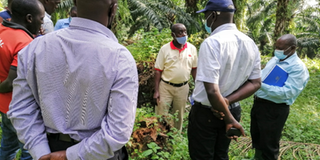Oil palm farmers tipped on disease control

Dr Gabriel Ddamulira (Centre, red collar t-shirt) and other experts in Kalangala to investigate the disease outbreak. PHOTO/ Shabibah Nakirigya
What you need to know:
Uganda, through Naro, is working with other institutions in Africa to introduce oil palm disease resistant varieties that are globally accepted as the most effective measure against Fusarium wilt.
Smallholder oil palm farmers in Kalangala District have been advised to adopt best management practices in order to control oil palm diseases, especially Fusarium wilt and Ganoderma.
The advice is contained in a report by a technical team from the National Agricultural Research Organisation (Naro) and the National Oil Palm Project (NOPP) that went to Kalangala following media reports of a disease outbreak.
Fertilisers
“Practices such as use of fertilisers are important in averting abiotic conditions that predispose palms to disease attack,” says a technical disease assessment report authored by Dr Gabriel Ddamulira, the principal oil palm researcher; Moses Otuba, a pathologist from Naro, and Charles Sembatya, the NOPP agronomist.
Smallholder oil palm farmers and representatives of the Kalangala Oil Palm Growers Trust (KOPGT) were the other members of the investigation team. “Therefore, good field practices are the first step in fighting diseases of oil palm in Kalangala,” the report reads.
Farmer fields
The assessment team sampled smallholder farmer fields in Kayunga and Kagulube blocks.
In their observations, they indicated that the fields in Kayunga Block were relatively well managed with one case of Ganoderma trunk rot (0.86 per cent), two cases of palm weevil (1.72 per cent) and one case of boron deficiency (0.86 per cent). The assessment was carried out in presence of the unit leader and oil palm farmer, Deo Ssesanga.
Fusarium wilt attack
However, in Kagulube and Busanje, Fusarium wilt was observed to be prevalent in poorly managed fields and those largely planted on sandy soils.
“Current surveillance results indicate Kagulube to have the highest percentage incidence (12.4 per cent) of Fusarium wilt compared to other blocks that have been currently cleared off Fusarium wilt symptomatic palm,” the report reads.
Deficiencies
Nutrient deficiencies were also identified.
“There is an oil palm field in Kagulube Block, which is located on hilly and rocky terrain with 30 per cent palms expressing magnesium deficiencies and two palms showing folded leaves, a sign of boron deficiency. Interaction with field supervisor indicated that the field has not been applied with appropriate fertiliser to address the nutrient required hence the manifestation of boron and magnesium deficiencies,” the report further reads. “The application of fertilisers in the right amount is anticipated to boost yields and reduce on nutrient deficiencies,” the report says.
In order to avert nutrient deficiencies, a palm tree needs eight kilogrammes of fertiliser in addition to use of cover crops, decanter cake and empty bunches that conserve soil moisture and boost palm growth especially in sandy soils and rocky areas. Similarly, woody shrubs must be regularly removed to avoid nutrient competition with oil palm trees.
Resistant varieties
Uganda, through Naro, is working with other institutions in Africa to introduce oil palm disease resistant varieties that are globally accepted as the most effective measure against Fusarium wilt.
“Naro is working with advanced oil palm research institutions in other parts of Africa such as CIRAD-Benin and OPRI-Ghana, which has led to the importation of Fusarium wilt resistant varieties from Palm-Elite (CIRAD-Benin) as a potential substitute to the susceptible oil palm hybrids,” Dr Ddamulira says.
“The resistant varieties are currently being evaluated at Namulonge for resistance against the strain of Fusarium wilt identified in Kalangala. The results will guide the adoption of Fusarium wilt resistant varieties in the expanding oil palm industry in Uganda,” he says.
In the meantime, pest control is crucial in improvement of oil palm productivity.
“Naro with its collaborating partners is setting up traps in the buffers to lure and kill the weevils before their population exceeds the economic threshold. Presently farmers in Kayunga Block are drenching young palms in rocket to control palm weevils,” the report says.
Wilt
In Kagulube and Busanje united, Fusarium wilt was observed to be prevalent in poorly managed fields and those largely planted on sandy soils. “Current surveillance results indicate Kagulube to have the highest percentage incidence (12.4 per cent) of Fusarium wilt compared to other blocks that have been currently cleared of Fusarium wilt symptomatic palm,” the report reads




